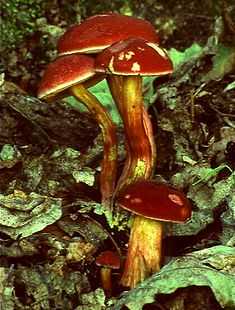Boletus rubellus
| Boletus rubellus | |
|---|---|
 | |
| Conservation status | |
| Rare in Britain | |
| Scientific classification | |
| Kingdom: | Fungi |
| Division: | Basidiomycota |
| Class: | Agaricomycetes |
| Order: | Boletales |
| Family: | Boletaceae |
| Genus: | Boletus |
| Species: | B. rubellus |
| Binomial name | |
| Boletus rubellus Krombh. | |
| Synonyms | |
|
Boletus versicolor C. Martín | |
| Boletus rubellus | |
|---|---|
|
| |
| pores on hymenium | |
|
cap is convex or flat | |
| stipe is bare | |
|
spore print is olive to brown | |
|
edibility: edible but not recommended | |
Boletus rubellus, commonly known as the Ruby Bolete, is a small, dainty, brightly coloured member of the Boletus genus, with a reddish cap and stipe, and yellow pores. Like many boletes, it stains blue when cut or bruised. It is found in deciduous woodland in autumn. There is some question over its edibility, and it is reportedly of poor quality with a taste of soap.
Taxonomy
Boletus rubellus was one of the pored basidiomycetes to be placed in the genus Xerocomus in the past, and is still regarded as such in some texts.[1] The previously commonly used binomial name Boletus versicolor (Rostk.), published in 1844, is now reduced to synonymy as it postdates the current name by German mycologist Julius Vincenz von Krombholz which dates from 1836. Its present specific epithet rubellus is Latin for "somewhat red".[2]
Description
This mushroom has a cap that is scarlet to raspberry red when young, with a dry velvety texture. The extreme margin often has a pale yellow or white band around it, (as in the photograph on the right) and it discolours darker, and dirtier with age. It is a small bolete, with the cap being rarely over 6 centimetres (2.4 in) in diameter.[3] The pores are small; pale yellow,[4] and bruise slowly. Sometimes tapering, the stem is slender and long, and may reach 7.5 cm (3.0 in). It is lemon yellow at the apex, but red elsewhere, and has a tendency to split or sheer vertically. The flesh is straw-coloured in the cap, and stains slowly blue over the tubes when cut. The flesh of the stem is pale yellow at the apex and yellow further down. At the stem base, the flesh may have a distinct spot of brick-red or orange.[5] The tubes and pores are large and lemon-yellow, and may be greenish tinged when older. The spore print is olive.[3] It smells pleasant, but indistinct, and is said to taste slightly soapy.[3]
Conflicting information on pore size in notable publications is a possible indication that there may be more than one species involved, both in Britain and in North America.[6] Boletus campestris is very similar, and Boletus bicolor is almost identical. Neither of these are reported in the British Isles. In Europe, this species is often mistaken for the all too similar Boletus armeniacus which, however, does not show the same red coloration in the stem base.
Distribution and habitat
Uncommon to rare in Southern England, occurring largely with oak (Quercus). It also appears in Europe, and the Eastern United States.[3] A similar species noted as "cf versicolor" has been collected from Victoria in southeastern Australia.[7]
Edibility
It is edible, but often maggoty, and some sources describe the taste as soapy.[3]
See also
References
- ↑ Lamaison, Jean-Louis; Polese, Jean-Marie (2005). The Great Encyclopedia of Mushrooms. Könemann. p. 25. ISBN 3-8331-1239-5.
- ↑ Simpson DP (1979). Cassell's Latin Dictionary (5 ed.). London: Cassell Ltd. p. 883. ISBN 0-304-52257-0.
- ↑ 3.0 3.1 3.2 3.3 3.4 Roger Phillips (2006). Mushrooms. Pan MacMillan. p. 282. ISBN 0-330-44237-6.
- ↑ Marcel Bon (1987). The Mushrooms and Toadstools of Britain and North Western Europe. Hodder and Stoughton. ISBN 0-340-39935-X.
- ↑ "Xerocomus rubellus at grzyby.pl". Grzyby.pl. Retrieved July 20, 2009.
- ↑ David Arora (1986). Mushrooms Demystified. Ten Speed Press. ISBN 0-89815-169-4.
- ↑ Watling R, Hui LT (1999). Australian Boletes - A Preliminary Survey. Edinburgh: Royal Botanic Gardens Edinburgh. p. 42. ISBN 1-872291-28-7.